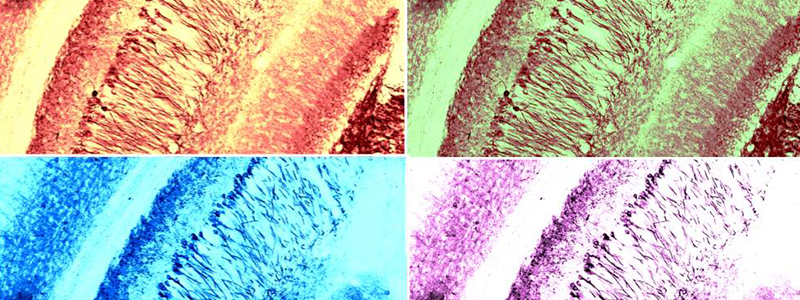Alzheimer’s disease is a neurodegenerative disease characterized by two types of lesions: amyloid lesions and neurofibrillary tangles linked with the accumulation of aggregated Tau proteins. As part of a collaborative project between the Centre de Recherche Jean-Pierre Aubert (Inserm UMR-S 1172, Université de Lille), the Institut du Cerveau – ICM and the Centre de Recherche St Antoine, researchers looked at the activation of the immune system in a mouse model of Tauopathy, mimicking the degeneration caused by the Tau protein. They showed an infiltration of pathogenic T-cells in the animals’ brain, with deleterious effects on cognitive functions. Their results, published in Brain, open the way to the identification of novel therapeutic targets to treat the disease.
Alzheimer’s disease is the most frequent cause of dementia. It affects about 900 000 individuals in France and more the 25 million in the world. There are two types of lesions in the disease, amyloid lesions caused by aggregates of Aβ peptides and neurofibrillary tangles caused by the accumulation in the neurons of aggregated Tau proteins (tauopathy). Tau protein is essential for neurons functioning but its aggregation leads to dysfunction followed by neurons death.
As part of a project coordinated by David Blum and Luc Buée from the Centre de Recherche Jean-Pierre Aubert (Inserm UMR-S 1172/Université de Lille), in collaboration with Stéphane Hunot and Cécile Delarasse from the Institut du Cerveau – ICM and Guillaume Dorothée from the Centre de Recherche St Antoine, the scientists looked at the activation of the immune system in a mouse model of Tauopathy, mimicking the degeneration observed in Alzheimer’s disease.
More and more data show a role of inflammation in Alzheimer’s disease. The production of inflammatory molecules, the chemokines, by the microglial cells, which are the main immune cells of the brain, was observed during the disease in previous studies. And it is actually the case in the mouse model of tauopathy. One of the main functions of chemokines is to attract the immune system cells to a specific site in the organism.
Over a first phase, researchers sought to identify what type of cell are attracted by these chemokines: innate immune system cells, such as macrophages, or adaptive immune system cells like B- or T-cells. They highlighted an infiltration of T-cells in the mice brain. This infiltration of T-cells can also be found in patients with genetic tauopathy.
In a second phase, the scientists looked at the role of these T-cells in the disease. To address this question, they eliminated of T-cells in the animals, using an antibody. The elimination of T-cells, thus abolishing their infiltration in the brain, led to memory improvement in mice, highlighting the deleterious effects of these cells of cognitive functions.
These discoveries constitute a major step forward in the understanding of Alzheimer’s disease mechanisms but maybe also for other neurodegenerative diseases, especially regarding the role of T-cells in those diseases. Researchers now wish to better identify the type of lymphocytes involved, their way of functioning and the ideal moment to intervene, as well as study the chemokines as potential therapeutic targets.
Référence : Hippocampal T cell infiltration promotes neuroinflammation and cognitive decline in a mouse model of Tauopathy. Laurent et al. Brain 2016.







